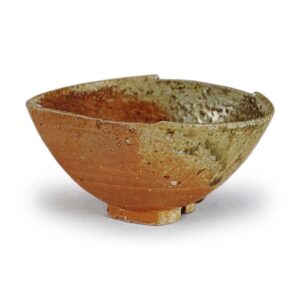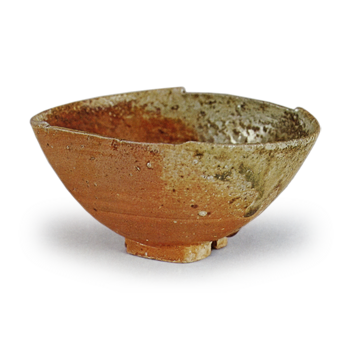
Height 7.3cm, Bowl diameter 11.7cm x 14.2cm, Stand diameter 4.6cm
This is a well-known Enshu’s favorite tea bowl in the Enshu Kirigata style, and is described in the “Enshu Kuracho” as “Hanabachibana Shigarakuhako Sofu-ko (poem) Fukuro Ezo Nishiki. The mouth is long and square with shallow incisions on the two long sides. The tea bowl is in the so-called “brush washing” shape, and the takadai is also in the “natsukashikata” shape with shallow incisions on three sides. It is a tea bowl with a Xiaozhu style of production that is truly worthy of the Enshu-kiri-shiki tradition. There are many other brush-washing tea bowls like this one in Shigaraki, and this may be the ancestor of them. The fine-grained clay skin is hardened and covered with a young grass-colored ash glaze on the inner surface and one side of the body, and the inner surface has a beautiful glassy appearance with the glaze pooling at the prospective edges. The inner surface has a beautiful glassy appearance with a glaze on the front. The surface of the clay is burnt red, so the entire bowl has a graceful appearance.
On the front of the lid of the inner box, there is a poem “Hana-tachibana” written in gold-painted letters, and on the back of the lid, there is a poem “Mukashi-sa-ohana-tachibana no kakarise wa nakarise wa nani ni tsuke ni kashimashimashita”. The author is said to have been Kobori Enshu. The origin of the scroll after Enshu is unknown, but it was passed down through the Akahoshi Yanosuke family, the Ueno Yokichi family, the Fujita Tokujiro family, and others after the Meiji era (1868-1912).



